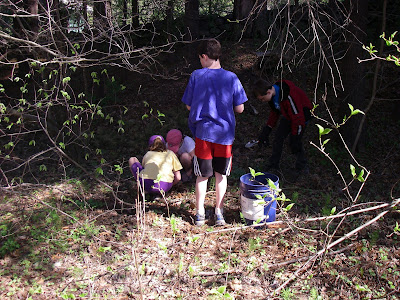 |
| Bipalium adventitium is an introduced terrestrial flatworm that inhabits soils and predates earthworms. |
I am not an invertebrate zoologist, so I was quite surprised to learn about this animal last year. Nicki Hall and I were checking snake cover boards for the last monitoring visit of the season (October 2011) and discovered what looked like a brown "leech". We didn't think much of it at the time, except that it was on land and that it was after all of the rain we received after Hurricane Irene. About a week later some colleagues in the state asked me if I had seen this mystery animal and in fact I had! After a short review from the internet, I found that this organism is introduced to North America from Asia and it is a predator to other soil invertebrates, especially earthworms. There are a few investigators trying to search for these animals in North America to document the spread. Peter Ducey, SUNY Cortland, is examining the natural history and the ecological role of Bipalium adventitium as potential competitor to native herpetofauna that consume earthworms.
 |
| Blue-spotted x Jefferson Salamander is a state endangered species in CT that inhabits White Memorial and eats earthworms. |
All of the earthworms that inhabit Connecticut's soils are considered introduced because our region was covered in glaciers only 15,000 years ago. Therefore, earthworms were not able to colonize this region until humans introduced them. Several of these species originated from other continents and are now changing our soils. In forest habitats, these animals are consuming the leaf litter layer that blankets the forest floor so fast that the entire layer is consumed and the soil is exposed to rain, thereby causing extensive erosion. This lowers water quality and decreases the ability of the forest to regenerate after other disturbances. Many species of forest dwelling plants depend on the leaf layer as part of their natural history and these species are declining as result of this ecological damage. I briefly mentioned in a previous blog post how Japanese Barberry, an invasive shrub, is also contributing to this scenario.
If introduced earthworms are doing damage to the forest leaf layer, then wouldn't another predator controlling earthworm populations be a good thing? John Gorsuch, an undergraduate student at the University of Cincinnati, is examining the effectiveness of B. adventitium as a predator to various earthworm species. John's preliminary observations suggest that B. adventitium can be an effective predator to some earthworm species but not all. Amynthas agrestis is an introduced earthworm from Asia and it is one of the few dirty words among forest ecologists (please pardon the pun). A. agrestis in one of those aforementioned earthworms that are aggressively consuming the leaf litter, but it also has several defense mechanisms to predators, B. adventitium and herpetofauna alike. Therefore, we are potentially left with several predator species that are generalists consuming every earthworm species except for one species that is causing severe ecological damage to a critical habitat!
What can you do?
Report all of your sightings of B. adventitium to Peter Ducey. Since these species (earthworms and flatworms) have been introduced to North America from the horticultural industry, it is best to use native species in your garden raised by local growers using local stock for their plants, soils, and amendments. If you use worms as bait for fishing, throw any remaining worms into the garbage NOT YOUR GARDEN! And finally, learn as much as you can about this topic (soil, earthworms, invasive species, forest ecosystems, etc.) on your own because soil is one of our vital natural resources that we all need, so take care of it.















